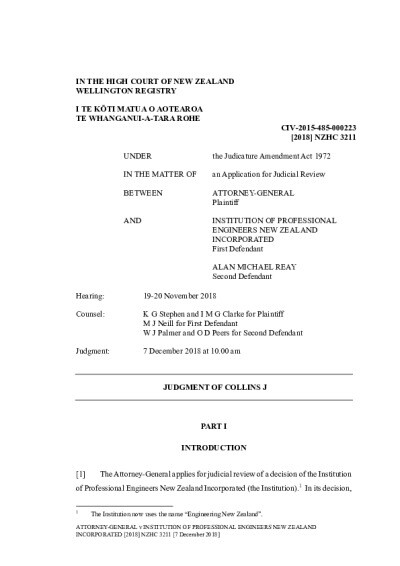
Date
Geographical Area
Pacific
Countries
New Zealand
Case Name
Attorney-General v Institute of Professional Engineers New Zealand Incorp & Ors
Case Reference
[2018] NZHC 3211
Name of Court
High Court of New Zealand
Key Facts
Following the 7.1 magnitude earthquake which struck Canterbury on 4 September 2010, a devastating 6.3 magnitude aftershock struck close to the city of Christchurch on 22 February 2011. This aftershock caused widespread damage to property and the deaths of 185 people, 115 of those died when the Canterbury Television (CTV) building collapsed.
The CTV building was a six-storey office building designed by Allen M. Reay Consulting Engineer. Most of the structural design work was carried out by Harding, a civil engineer employed at the firm. A Royal Commission of Inquiry into various aspects of the earthquakes found significant defects in the structural design of the CTV building and it criticised Reay for failing to adequately supervise Harding when he knew that Harding lacked the requisite experience to design such a challenging building.
No criminal charges could be laid against Reay or Harding due to the year-and-a-day rule (s.162 of the Crimes Act) and New Zealand’s compulsory insurance for personal injury – the Accident Compensation Corporation – prevents civil proceedings for personal injury. So, seeking responsibility for the collapse, a complaint was made under Rule 4 of the Chartered Professional Engineers of New Zealand Act 2002 on the basis that Reay had breached the Institute’s code of ethics. The complaint against Reay was dismissed by the Institute when he resigned, as they claimed they could only discipline current members.
Harding also resigned, but a Court found that disciplinary proceedings could continue: Harding v Institute of Professional Engineers New Zealand Inc [2014] NZHC 2251. Following this, the Attorney-General requested the Institute to reconsider the complaint against Reay, it claimed it did not have jurisdiction to do so.
The CTV building was a six-storey office building designed by Allen M. Reay Consulting Engineer. Most of the structural design work was carried out by Harding, a civil engineer employed at the firm. A Royal Commission of Inquiry into various aspects of the earthquakes found significant defects in the structural design of the CTV building and it criticised Reay for failing to adequately supervise Harding when he knew that Harding lacked the requisite experience to design such a challenging building.
No criminal charges could be laid against Reay or Harding due to the year-and-a-day rule (s.162 of the Crimes Act) and New Zealand’s compulsory insurance for personal injury – the Accident Compensation Corporation – prevents civil proceedings for personal injury. So, seeking responsibility for the collapse, a complaint was made under Rule 4 of the Chartered Professional Engineers of New Zealand Act 2002 on the basis that Reay had breached the Institute’s code of ethics. The complaint against Reay was dismissed by the Institute when he resigned, as they claimed they could only discipline current members.
Harding also resigned, but a Court found that disciplinary proceedings could continue: Harding v Institute of Professional Engineers New Zealand Inc [2014] NZHC 2251. Following this, the Attorney-General requested the Institute to reconsider the complaint against Reay, it claimed it did not have jurisdiction to do so.
Decision and Reasoning
The Court first considered whether it was possible for the Attorney-General to bring the proceedings in his own right, not just on behalf on the complainant. The judge found that he could, as there is significant and genuine public interest in ensuring professional disciplinary procedures are done in accordance with the law, the CTV collapse was a “major national disaster”, and Reay, through the code of ethics, was required to recognise his responsibility to the public interest. The Court also found that judicial review into disciplinary proceedings is appropriate, especially where it involves issues of legal interpretation.
Under the Institute’s Rules, they were only able to discipline a member, so the Court had to determine whether Reay was a member. Citing the principles of contractual interpretation, the Court found that the term ‘member’ includes a person who was a member when disciplinary proceedings commenced but has since resigned. This was because the use of ‘member’ in the Rules was not limited to situations where people currently held membership, and a reasonable person reading the relevant Rules would have been reluctant to conclude that the Institute intended a member to escape disciplinary proceedings by resigning, as this would undermine public trust. Furthermore, the Rules only specify that membership is a requirement at the time of the complaint.
Under the Institute’s Rules, they were only able to discipline a member, so the Court had to determine whether Reay was a member. Citing the principles of contractual interpretation, the Court found that the term ‘member’ includes a person who was a member when disciplinary proceedings commenced but has since resigned. This was because the use of ‘member’ in the Rules was not limited to situations where people currently held membership, and a reasonable person reading the relevant Rules would have been reluctant to conclude that the Institute intended a member to escape disciplinary proceedings by resigning, as this would undermine public trust. Furthermore, the Rules only specify that membership is a requirement at the time of the complaint.
Outcome
The Court made two declarations: first, that the Institute has jurisdiction to investigate the complaint; second, it was wrong in law to dismiss the complaint.
Link
Disclaimer
This case law summary was developed as part of the Disaster Law Database (DISLAW) project, and is not an official record of the case.
Document
Document